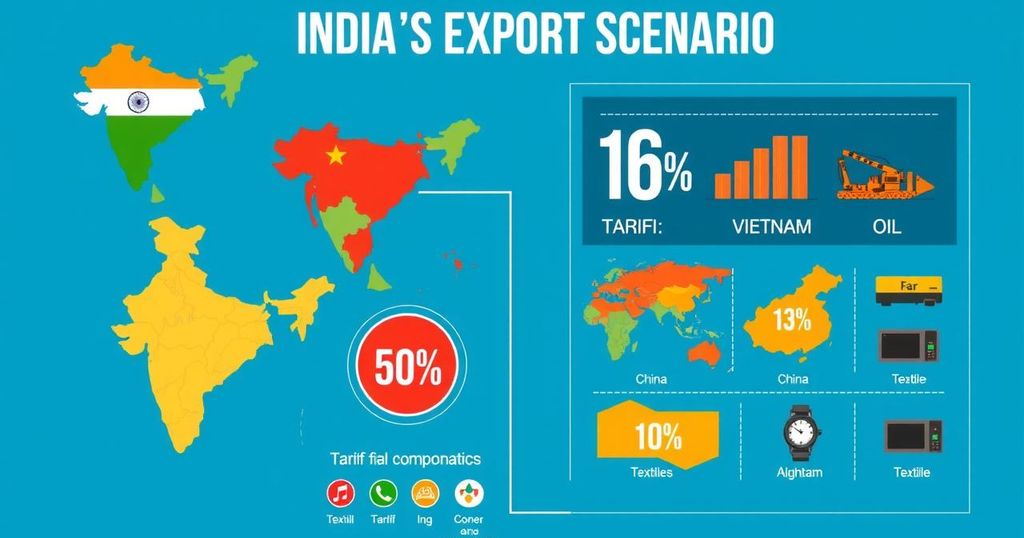Impact of Trump Tariffs on Indian Exports: Winners and Losers

India ranks as the 12th-largest exporter, facing a 27% tariff on exports to the US. Competitors like China and Vietnam face steeper tariffs, potentially allowing India to gain in textiles and gems. Auto and electronics sectors face challenges, while ongoing trade negotiations might provide relief.
In 2023, India ranked as the 12th-largest exporter globally, with total exports valued at $441 billion. Following the introduction of a 27% flat tariff on all Indian exports to the United States, Indian exporters now face significant challenges. However, India may have a competitive edge over countries such as China, Vietnam, Bangladesh, and Indonesia, all of which face steeper tariffs.
China contends with a 34% tariff, while Vietnam experiences a 46% tariff. Bangladesh and Thailand are subjected to tariffs of 37%, and Cambodia has the highest at 49%. Sri Lanka follows with a 44% tariff, placing Indian exporters in a relatively favorable position amid the turmoil.
For the automotive industry, the US has imposed a 25% tariff on imported vehicles. This is expected to influence major Asian manufacturers, including Toyota, Honda, and Nissan. India’s automobile exports to the US are minimal, constituting only 0.13% for passenger vehicles and 3% for commercial vehicles. Tata Motors might face indirect effects through its luxury car brand, Jaguar Land Rover.
In terms of auto components, Indian exports to the US are about one-third of its $21.2 billion total auto component industry exports. However, these account for just 2% of the US auto component imports, which are dominated by Mexico (39%), Canada (13%), and China (12%). In 2023, less than 0.5% of India’s car exports went to the US, with primary markets being Saudi Arabia, South Africa, and Mexico.
The textile sector in India is poised to gain from the new tariff scheme, as competitors such as Vietnam, Bangladesh, and China face considerably higher duties. In fact, the US import duty levied on textiles is 46% for Vietnam, 37% for Bangladesh, and 34% for China. India’s textile sector contributes 2% to the GDP, significantly less than Bangladesh (11%) and Vietnam (15%), mitigating vulnerability.
India maintains a strong presence in the gems and jewellery market, accounting for almost 13% ($11.58 billion) of total US imports. India’s rivals, including France, Italy, UAE, and Thailand, contribute much smaller proportions. The new tariffs may heavily impact Indian exporters in this sector relative to competitors.
Key agricultural exports from India affected by the tariffs include basmati and non-basmati rice, buffalo meat, and wheat. Despite the 27% tariff, India can capitalize on pricing advantages in processed food items over China, Vietnam, Thailand, and Bangladesh. Conversely, India may suffer comparative disadvantages against Mexico due to tax breaks under the USMCA, which includes low tariffs on compliant agricultural goods and advantageous shipping costs.
India exported electronic goods valued at $14 billion to the US, and the new 27% tariffs will increase costs. However, India still holds a better position compared to Vietnam (46%) and China (34%). Mexico retains an advantage with tariff-free access under the USMCA for compliant goods, while non-compliant items now face a 25% tariff.
The prospects of forthcoming bilateral trade agreement negotiations between India and the US may provide some respite from these tariffs. Overall, India could emerge more competitive in specific sectors, despite facing numerous challenges due to increased tariff barriers.
In summary, while India’s exporters confront hurdles due to a 27% tariff on exports to the US, they may benefit from a favorable position compared to major competitors like China and Vietnam, who face higher tariffs. Specific sectors such as textiles and gems and jewellery could see positive growth, while others like automobiles and agriculture may experience setbacks. Ongoing negotiations with the US could further alleviate some tariff impacts, maintaining India’s competitive edge in certain markets.
Original Source: www.business-standard.com





